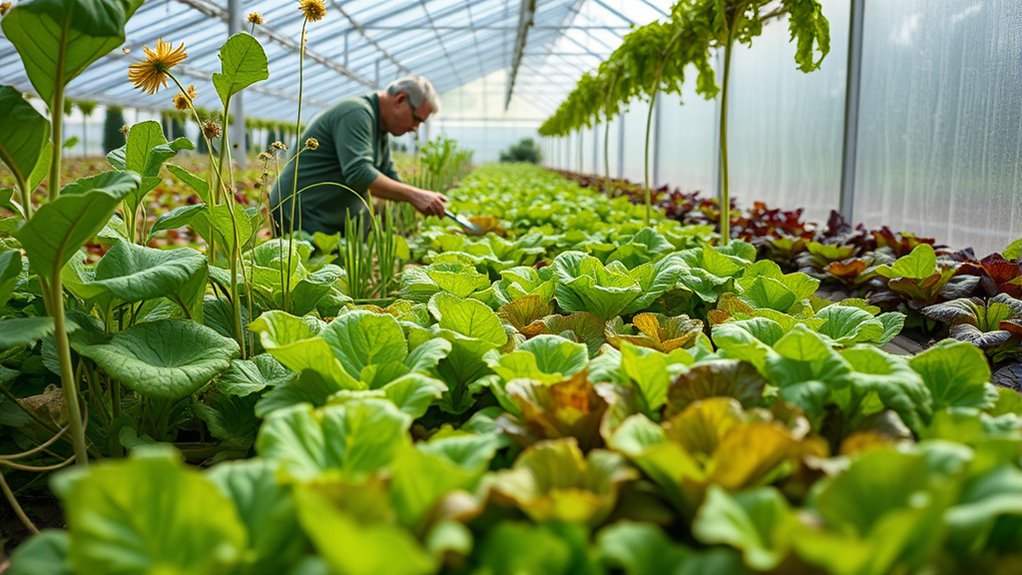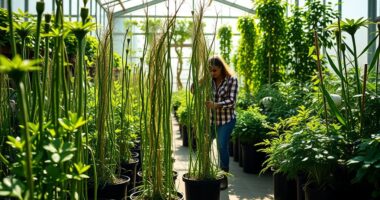To effectively deal with bolting in greenhouse vegetables like lettuce and spinach, maintain consistent temperatures below 75°F and provide shade during hot days. Guarantee regular watering to prevent drought stress and use mulch to stabilize soil temperature. Consider planting bolt-resistant varieties and employ succession planting for steady harvests. Regularly monitor conditions and prune flower buds to minimize stress. For more in-depth strategies on managing specific crops, you'll want to explore additional tips.
Key Takeaways
- Plant cool-season crops early in spring or late in fall to avoid high temperatures and bolting.
- Use shade cloths to protect vegetables from excessive sunlight and regulate soil temperatures.
- Maintain consistent watering practices to prevent drought stress and support healthy growth.
- Implement succession planting to ensure a steady harvest and reduce the risk of bolting.
- Monitor growing conditions closely and prune flower buds promptly to minimize stress on the plants.
Understanding Bolting in Vegetables
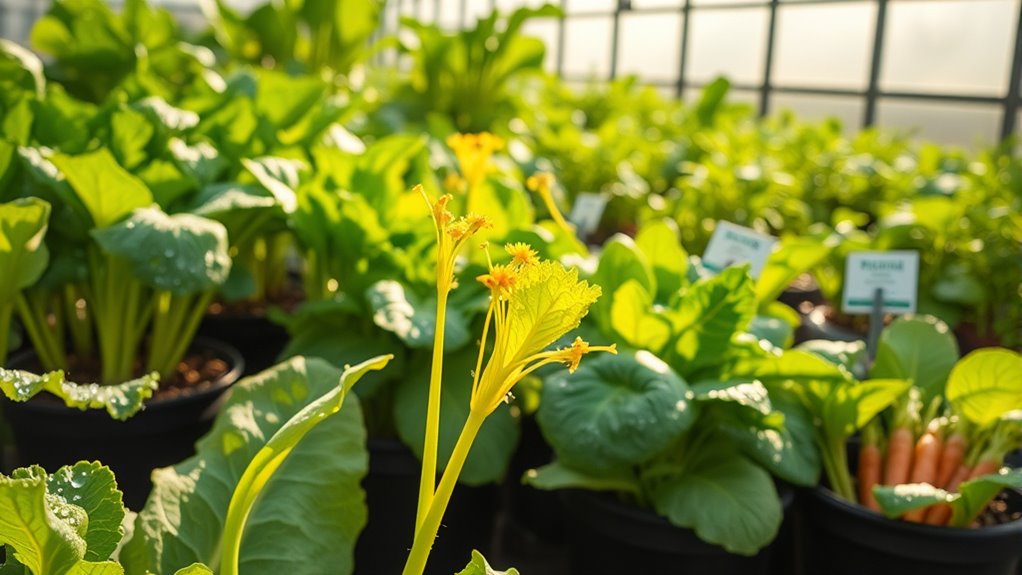
Bolting occurs when vegetable plants flower and produce seeds prematurely, often rendering them unusable. This process primarily affects annual vegetables like lettuce and spinach, as well as biennial plants such as onions and carrots.
When bolting happens, you might notice a decline in the quality and taste of your harvest, with many vegetables developing a bitter flavor. The stems and roots can also become woody and unpalatable, reducing the usable yield.
While bolting is a natural part of a plant's life cycle, it can occur prematurely due to environmental factors. Understanding bolting is essential for you as a gardener, helping you manage your plants effectively and maximize your harvests.
Common Causes of Bolting

Many factors can contribute to bolting in greenhouse vegetables, and understanding them is key to preventing this issue. Increased day length often triggers flowering in sensitive plants like lettuce and spinach.
High soil temperatures can stress crops such as broccoli and cauliflower, leading to premature bolting. Root stress from transplanting or insufficient space affects vegetables like carrots and turnips.
Additionally, water stress, particularly in dry conditions, can accelerate bolting in crops like cauliflower. Cold spells can also provoke bolting in biennial plants like onions.
Temperature fluctuations, inconsistent moisture levels, and poor soil conditions further exacerbate these challenges. By recognizing these causes, you can better manage your greenhouse environment and minimize the risk of bolting.
Effects of Bolting on Crop Quality
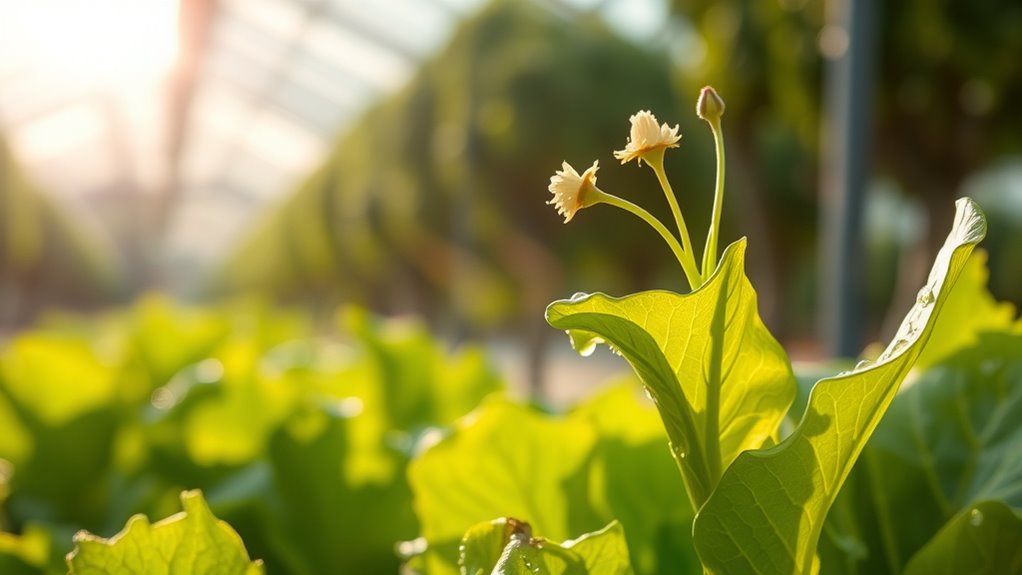
How does bolting affect the quality of your greenhouse vegetables? When plants bolt, you'll notice significant changes in flavor and texture.
For instance, lettuce and spinach can become bitter, while the texture often turns tough or fibrous. This shift diverts resources from edible parts to seed production, leading to reduced harvest quality and nutritional value.
You might also see flower stalks forming, which can make your crops look unsightly. Additionally, bolting shortens your harvest period, as plants stop producing new leaves.
The overall market value decreases, and you may face increased labor costs to manage these crops. Ultimately, consumers may be dissatisfied with the quality, affecting your sales and reputation in the market.
Preventing Bolting in Greenhouse Conditions
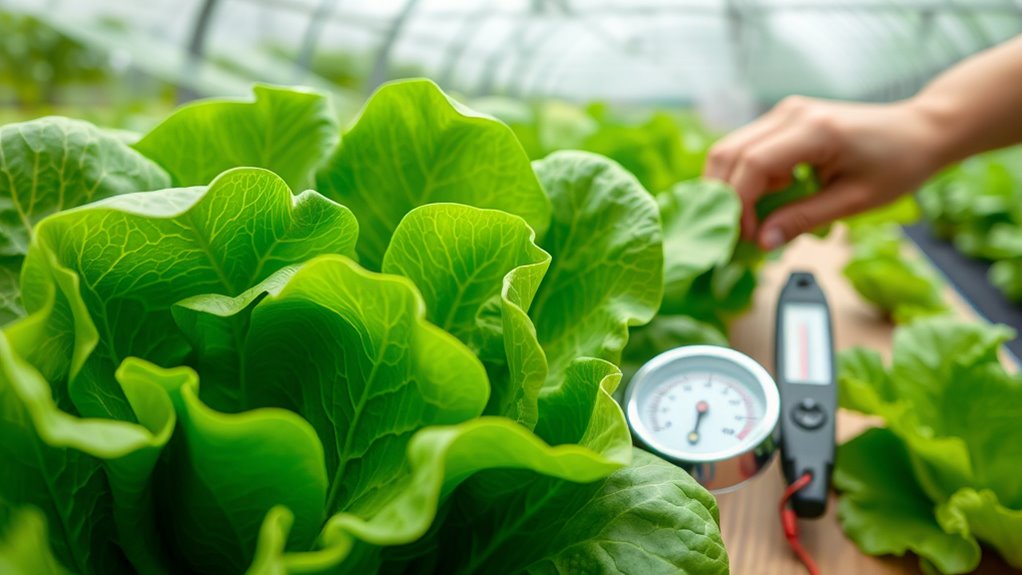
To effectively prevent bolting in your greenhouse vegetables, you'll want to implement a combination of thoughtful planting strategies and environmental controls.
Start with seasonal planting of cool-season crops like lettuce and spinach in late spring or early fall to avoid heat stress. Consider succession planting to guarantee a steady harvest, and choose bolt-resistant varieties.
Transplant mature seedlings to help them reach maturity before bolting occurs. Maintain consistent temperatures below 75°F (24°C) and provide shade during hot days to reduce stress.
Consistent watering and balanced nutrients are essential for healthy growth. Finally, keep an eye on pests and diseases, as managing these factors will help maintain plant vigor and delay premature flowering.
Managing Temperature and Light in Greenhouses
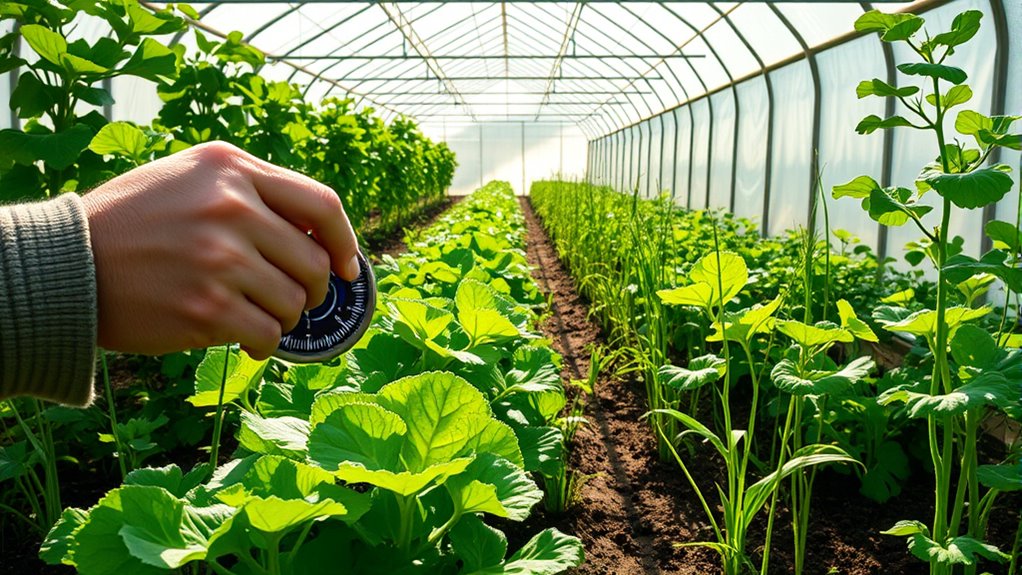
Preventing bolting in greenhouse vegetables hinges on managing the right environmental conditions, particularly temperature and light. Most crops thrive best between 64-75°F, but some may need specific ranges.
Use fans, heaters, and misting systems to maintain favorable temperatures, adjusting for seasonal changes—75-85°F during summer days and 65-70°F in winter.
Light also plays a vital role; most crops are light-saturated at 4000 foot-candles. If natural light isn't sufficient, consider supplemental lighting and shading techniques to balance intensity and prevent overheating.
Soil and Water Management Strategies

Effective soil and water management strategies are essential for keeping greenhouse vegetables healthy and reducing the risk of bolting.
Start by mulching with materials like straw or wood chips to keep soil cool and moist. Guarantee consistent soil moisture to prevent root stress, which can lead to bolting.
Adding organic matter enhances soil structure and moisture retention, while maintaining ideal pH supports healthy growth.
For water management, implement efficient irrigation systems to deliver the right amount of water without oversaturation. Regularly monitor soil moisture levels and use clean water to avoid plant stress.
Finally, practice direct sowing and care during transplanting to minimize root disturbance and promote robust root systems.
Choosing Bolt-Resistant Varieties

When selecting bolt-resistant varieties for your greenhouse, it's crucial to understand how these plants can enhance your crop management.
Selecting bolt-resistant varieties is essential for optimizing crop management in your greenhouse.
Bolt-resistant varieties, like Batavian and Butter lettuce, delay premature flowering, allowing for longer harvest periods and flexibility in your planting schedule. Research shows that these varieties can remain productive in warmer temperatures, helping you maintain crop quality.
By choosing varieties bred for resistance, you can mitigate factors like temperature and stress that trigger bolting. Consider local climate conditions and explore hybrid options that may offer improved resistance.
Implementing these strategies not only extends your harvest but also improves flavor and texture, ultimately leading to greater economic benefits and reduced crop loss.
Crop-Specific Strategies for Managing Bolting
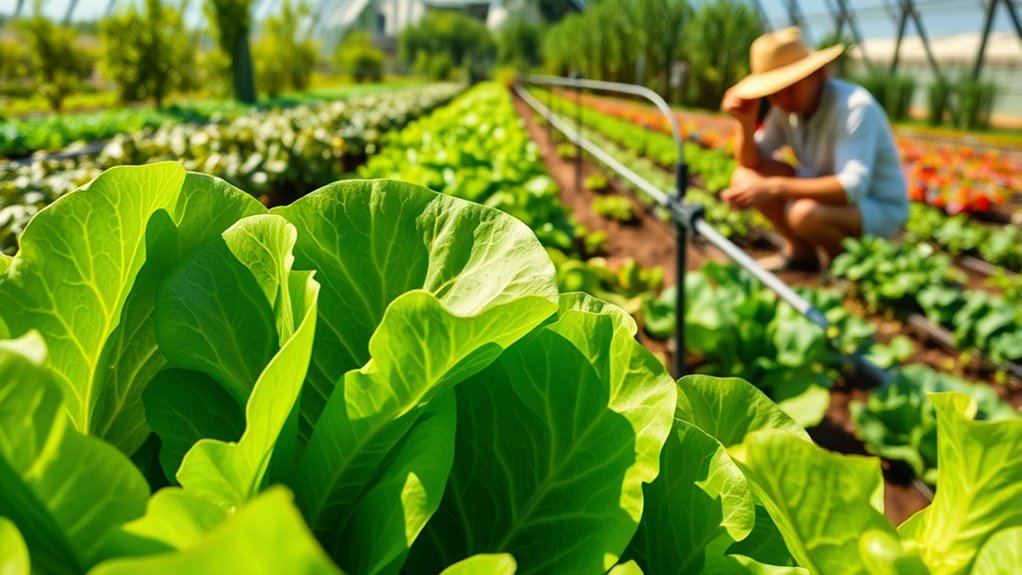
To manage bolting effectively in your greenhouse vegetables, you'll want to implement crop-specific strategies tailored to the unique needs of each plant type.
For cool-season crops like lettuce and spinach, plant early in spring or late in fall to dodge heat stress. Use shade cloths to protect them from harsh sunlight and maintain consistent soil temperatures with mulching.
Keep your crops well-watered to prevent drought stress and guarantee balanced soil fertility. Consider planting small batches every two weeks for a continuous harvest, avoiding peak heat periods.
Regularly prune flower buds to delay bolting, and monitor conditions to mitigate stress. By addressing these specific needs, you can promote healthier growth and reduce the risk of bolting in your greenhouse.
Long-Term Solutions for Sustainable Growth

As you aim for long-term solutions in sustainable growth, it's crucial to focus on practices that enhance soil health and reduce stress on your greenhouse vegetables.
Implement soil cooling techniques like mulching to keep temperatures down and prevent bolting. Maintain consistent soil moisture through regular watering to avoid drought stress.
Balance nutrients by using fertilizers with lower nitrogen to encourage leaf growth rather than flowering. Consider seasonal planting strategies; for instance, sow crops in the cooler months or employ succession sowing for a continuous harvest.
Finally, choose bolt-resistant and adaptable varieties suited to your local climate. By integrating these practices, you'll achieve healthier plants and reduce the risk of bolting in your greenhouse.
Frequently Asked Questions
What Signs Indicate a Plant Is About to Bolt?
When you notice a plant starting to bolt, look for specific signs.
You'll see a change in leaf shape, becoming thinner or more serrated. The plant might develop flowers at the top and the stem will thicken as it grows taller.
Additionally, the flavor of the leaves may shift, often turning bitter. Keeping an eye on these indicators helps you act before the plant fully bolts, ensuring better harvest quality.
Can Bolting Affect Fruit-Bearing Plants as Well?
While bolting typically affects non-fruiting plants, it doesn't apply to fruit-bearing ones like tomatoes and cucumbers.
You'll notice that fruiting plants naturally produce flowers, which is part of their lifecycle, not a sign of stress.
However, stress can still reduce your fruit yield.
How Does Bolting Impact the Nutritional Value of Crops?
Bolting can markedly impact the nutritional value of your crops. When plants bolt, they redirect energy from leaf growth to seed production, leading to a decrease in vitamins, minerals, and beneficial compounds.
You might notice a bitter taste and tougher texture in bolted vegetables, making them less palatable. Nutrient deficiencies can trigger this process, so maintaining a balanced nutrient supply is essential for preserving the quality and nutrition of your harvest.
Are There Organic Methods to Manage Bolting?
Absolutely, there are several organic methods to manage bolting in your crops.
First, you can select bolt-resistant varieties to minimize risk.
Succession planting helps stagger growth stages, reducing overall loss.
Mulching regulates soil temperature and moisture, easing stress on plants.
Transplanting mature seedlings allows you to harvest before bolting occurs.
Finally, maintaining ideal greenhouse conditions, like temperature and humidity, is essential to prevent premature flowering and improve your crop yield.
What Time of Day Is Best for Watering to Prevent Bolting?
You might think watering your plants anytime is fine, but you'd be mistaken!
The best time to water is in the morning. By doing this, you let your plants dry out before nightfall, reducing fungal disease risks.
Plus, watering during cooler parts of the day helps prevent heat stress that can trigger bolting.
Conclusion
In the world of greenhouse vegetables, managing bolting is like steering a ship through stormy seas. By understanding its causes and implementing effective strategies—like controlling temperature, optimizing soil, and selecting bolt-resistant varieties—you can keep your crops thriving. Remember, a little foresight can go a long way. Stay proactive in your approach, and you'll enjoy a bountiful harvest free from the bitter taste of bolting. Your plants will thank you for it!
